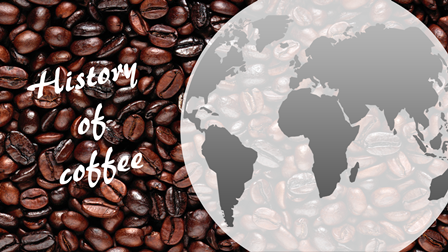Special Issue

 Ahmed H. Abdelazeem & Hebat-Allah Haggag - Cairo, Egypt
Ahmed H. Abdelazeem & Hebat-Allah Haggag - Cairo, Egypt
There are many legends concerning the discovery of coffee, but no one knows the exact story. The history of coffee is a daring adventure dating as far back as the 9th century, filled with death-defying escapes, intrigue and, even more, scandalous romance! Throughout history it has raised so much controversy from being banned and feared by some to being cherished and revered by others.
The most famous legend owes itself to a goat herder named Kaldi who noticed that his goats stayed awake all night after eating the berries of a certain tree. Kaldi took his findings to the local monastery, who in turn made a drink with the berries and found that it kept them alert through the long hours of evening prayer. In another corner of Ethiopia, a tribe by the name of Galla mixed the berry with ghee and pressed the mixture into a bar. After eating it their warriors marched into battle and were invincible!
Other legends involve the Moroccan Sufi Sheikh Abu al-Hasan al-Shadhili who while travelling in Ethiopia, observed birds of unusual activity, and, upon trying the berries that the birds had been eating, experienced the same hyperactivity. According to another legend it was his disciple Omar who tried chewing berries from a nearby tree after being exiled in the desert and found them so bitter. He tried roasting them to remove the bitterness, but they became hard. He then tried boiling them to soften the bean, and after drinking the resulting fragrant brown liquid, he became so energized and survived for days.
The first credible evidence of coffee appeared to be in the middle of the 15th century, in the Sufi monasteries of Yemen. Yemeni traders exported coffee from Ethiopia and cultivated the beans in Yemen. The word qahwa originally meant wine, and Sufis in Yemen used the beverage to increase concentration and endurance during their prolonged religious rituals. The name qahwa is not used for the plant itself but for the drink made from it.
By the 16th century, coffee's popularity spread all the way from Persia, Egypt, Syria, and Turkey to even Mecca, and the first coffee houses were thought to have been established there. They were known Kaveh Khans, and often used for religious meetings. Coffee shops opened in Constantinople, now Istanbul, around the same time. The Turks created their own clever concoction by adding spices such as clove, cardamom, cinnamon and anise. Coffee imbedded itself deeply into the Turkish culture to the extent that a law was created that made it legal for a woman to divorce her husband if he fails to satisfy her need of coffee. Coffee houses were often referred to as “Schools of the wise” as they were important hotspots for information exchange, discussions and political disputes.
In 1511 Governor Khayr Bey of Mecca banned the drink. He shut down shops as far away as Constantinople fearing its influence promoted energized discussions and debates that could lead to opposition to his rule. Riots broke out everywhere and the Sultan of Cairo had to intervene to prevent an inevitable revolution. He had the Governor executed and established the sacredness of coffee. As thousands of pilgrims visited the holy city of Mecca each year, word of this “wine of Araby” began to spread worldwide.
In 1570 coffee arrived in Venice. At first, this rare exotic drink was mainly for the very wealthy and rarely sold for medicinal purposes. Coffee created a huge controversy and people started being so suspicious of this new drink that they even called it the “bitter invention of Satan”. When the local clergy of Venice condemned it, Pope Clement VIII was asked to intervene. He decided to taste the beverage himself. After tasting it, he found it so satisfying that he said: "Why, this Satan's drink is so delicious that it would be a pity to let the Infidels have exclusive use of it. We shall fool Satan by baptizing it and making it a truly Christian beverage". The coffee was thus approved, and coffee houses opened in Vienna. The Viennese added sugar and milk to the coffee and thus “Viennese coffee” was created.
During that period, coffee production was made exclusive to Arabia and Muslim Africa, as their laws forbade the export of fertile beans. Coffee beans were boiled to make them infertile before allowing their export. However, an Asian Indian named Baba Budan once managed to leave Mecca after his pilgrimage with a few fertile coffee beans concealed against his stomach. He then secretly cultivated the beans after his return and the descendants of those beans are still producing coffee to this day! Owing to his success Baba Budan was made a Saint and a region of India was named after him.
The word "coffee" was introduced to the English language in 1582 via the Dutch word koffie, borrowed from the Turkish kahve, in turn borrowed from the Arabic qahwa (قهوة). Coffee houses in major cities in England, Austria, France, Germany and Holland quickly became centers of social activity and communication. In England “penny universities” appeared, where one could purchase a cup of coffee for one penny and engage in thought-provoking rich conversations. Common breakfast beverages started being replaced by coffee as those who drank it began the day alert and energized. It even improved the quality of their work. Charles II tried to shut down coffee houses in 1675 as he feared the consequences of deep religious and political discussions occurring there.
In the latter half of the 17th century, after finally managing to obtain the seedlings, the Dutch failed in their first attempts of cultivation. However, they then succeeded in planting the seeds on the island of Java; now Indonesia; and expanded the cultivation to the islands of Sumatra and Celebes. Soon the Dutch would have a productive and growing trade in coffee.
Coffee found its way to New Amsterdam, now known as New York, by the mid-1600s. Until 1773 tea continued to be the favored drink in the New World, however the protest of “The Boston Tea Party” against a heavy tax on tea imposed by King George III forever changed the American drinking preference to coffee. "Coffee - the favorite drink of the civilized world." - Thomas Jefferson
In 1714, a young coffee plant was gifted to King Louis XIV of France by the Mayor of Amsterdam and was planted in the Royal Botanical Garden in Paris. In 1723 a young naval officer managed to transport a seedling from the King's plant to Martinique, a French colony in the West Indies. The seedling thrived and spread to over 18 million coffee trees on the island and is considered to be the parent of all coffee trees throughout the Caribbean, South and Central America.
The story of the famous billion-dollar Brazilian coffee industry started when the emperor of Brazil sent to the French Guiana to get coffee seedlings. The French refused to share, but a Brazilian diplomate named Francisco de Mello Palheta secretly seduced the French Governor's wife and managed to leave with a bouquet of flowers that she gave him containing enough coffee seedlings buried inside.
Coffee seeds continued to be carried to new lands, and coffee trees were planted worldwide, some flourishing while others not. Coffee economies flourished, and fortunes were made and lost.
In 1822, with the beginning of the industrial age and the appearance of the first steam-powered locomotive, Louis Bernard Rabaut created the world's first espresso machine in France by forcing steam through the coffee grounds and creating the first early version of Espresso!
By 1938 the Brazilians were growing so much coffee that their government approached Nestlé to find a way to utilize the surplus. Max Morgenthaler and his team spent seven long years of research trying to find a way of producing a quality cup of coffee made simply by adding water yet retaining the coffee's natural flavor. Freeze dried coffee was their answer. The coffee was marketed as Nescafé and was introduced in Switzerland. To this day, Nescafé is the world's leading brand.
In 1946, Italian Achille Gaggia, evolved the espresso machine by using a piston to extract the brew at a higher pressure resulting in a layer of "crema" on the coffee and voila The Cappuccino was born!
Nowadays coffee is the world's most popular beverage, excluding nothing. We consume almost 400 million cups a day. Coffee is the second most traded commodity after oil. Coffee is not just a drink, it is magic that infuses itself into our psyche, stirring conflict and controversy.
- https://en.wikipedia.org/wiki/History_of_coffee
- http://www.ncausa.org/about-coffee/history-of-coffee
- https://www.gocoffeego.com/professor-peaberry/history-of-coffee/850
- https://www.historyextra.com/period/medieval/history-coffee-facts-discovery-use-drink-social-revolution/
- https://en.wikipedia.org/wiki/Boston_Tea_Party
- https://en.wikipedia.org/wiki/Coffee_production_in_Brazil



















